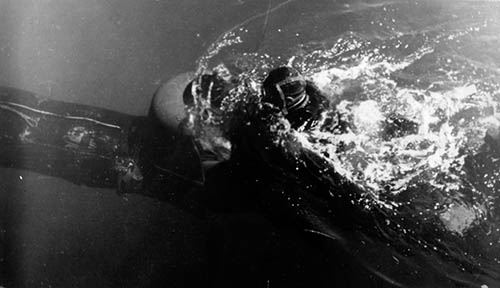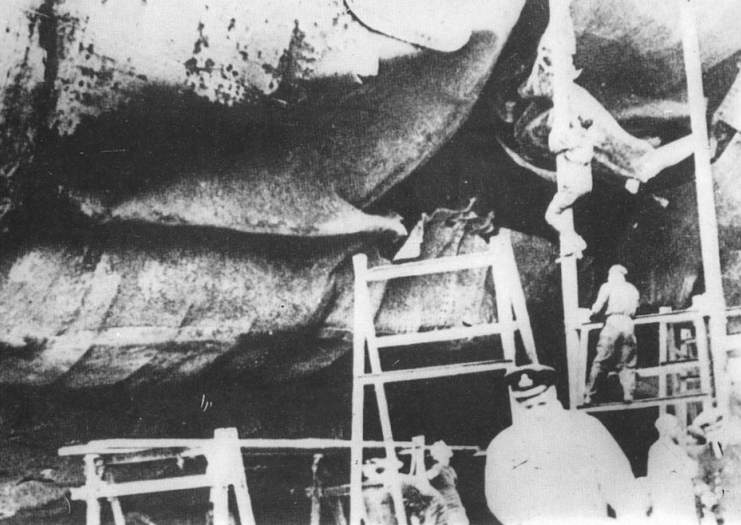In his memoir, Admiral Andrew B. Cunningham - commander of the Mediterranean Fleet of the Royal Navy, during the Second World War - he wrote:
For some time we suspected that the Italians were preparing an attack against the battleships. We knew that they possessed a kind of submersible explosive motorboats that could navigate on the surface or immersed, and equipped with devices to lift the nets, allowing the passage under normal obstructions. December 18th (1941, ed) I issued a signal to warn the fleet that we could expect, in calm weather conditions, attacks against Alexandria by torpedoes launched from airplanes, by naval vessels or driven by men (he was referring to the SLC, nda).
Leaving aside the origin of the source that had alerted Her Majesty's admiral, on the night between 18 and 19 December 1941, six incursors belonging to the Xᵃ Flotiglia MAS of the Royal Italian Navy, attacked the English fleet in the Mediterranean, at anchor in the port of Alexandria, Egypt.
He was aware of Supermarina that, the Mediterranean Fleet, used the Egyptian base to launch sorties along the Libyan coast to bomb the Italian-German rear lines - especially the supply lines - and support the movements of the British VIII army (on November 19 the offensive against the Italian-German forces took place ).
In order to inflict a severe blow to the British device, the commander of the Xᵃ, frigate captain Ernesto Forza, planned an attack (operation GA3) against Alexandria in Egypt, where the few photographs taken during the difficult aerial reconnaissance showed the presence of two battleships and an aircraft carrier.
The six raiders would first reach the island of Rhodes, and then move to the base of Porto Lago, on the island of Lero, where they would board the submarine Scirè, under the command of the Captain of Corvetta Borghese, in whose cylindrical bodies he carried the three pigs that they would be used against British ships: 221, 222 and 223.

The raiders selected for the GA3 operation were the best available to the Xᵃ Flottiglia, and all already had operational experience.
The crews were divided as follows: on the SLC 221, vessel lieutenant Durand de la Penne and head diver Emilio Bianchi; on the SLC 222, captain of the naval genius Antonio Marceglia and sub-chiefer Spartaco Schergat; on the SLC 223, captain of naval weapons Vincenzo Martellotta and head diver Mario Marino.
The plan called for the approach of the Scirè on the Egyptian coast, 5 miles from it, the three SLCs would be released into the sea, and they would have had to sail a little more than two and a half hours to reach the mouth of the port. Right from the start the six raiders were aware of the fact that they could not be recovered; for them, therefore, there were only two options: death or imprisonment.
On December 14 the Scirè took to the sea with the order to go towards Alexandria in Egypt. Late in the evening of 16 came a message from Supermarina that communicated probable presence of battleships at sea. Delay 24-hour attack.
On December 17, a reconnaissance aircraft of the Regia Aeronautica flew over the Alexandrian port. On the same day Borghese received a message from the commander Forza: ascertained presence in port of two battleships. Probable aircraft carrier. attach!
On the evening of the 17th Borghese assigned the objectives to the pairs of raiders: a de la Penne-Bianchi, the battleship in the mooring place n. 57; in Marceglia-Schergat, the battleship at berth no. 61; in Martellotta-Marino, the search for an aircraft carrier or, in the absence thereof, the attack on a large tanker, possibly fully laden.
At 20.47 pm on December 18th Scirè came to the surface for the launch of the three SLCs and their respective crews. From here began the adventure of the six sailors in Alexandria, Egypt.
The SLC 222 of Marceglia and Schergat went through the obstructions and, once inside the port area, took the route to reach its target.
Two cruisers, an unloaded merchant ship and the French battleship were spotted along a pier Lorraine. Finally, 300 meters away, the outline of the assigned target emerged, the battleship Queen Elizabeth. The couple of raiders went up about 30 meters from the ship, at which point Marceglia decided to dive.
 In his mission report he writes: we go down to 13 meters and begin to crawl on the bottom with a 180 ° course [...] at a certain moment I think I am under the hull, I am reconnoitering the diver who goes up for about 5/6 meters. Come back and show me to continue.
In his mission report he writes: we go down to 13 meters and begin to crawl on the bottom with a 180 ° course [...] at a certain moment I think I am under the hull, I am reconnoitering the diver who goes up for about 5/6 meters. Come back and show me to continue.
They are in correspondence with the starboard roll fin, to which I assure the device with a clamp. [...] Schergat detached the charge of the pig warning me that he feels ill. I finish the job on my own: I bring my head to the keel of the ship, I assure her with the rope on top at a distance of one meter and a half from the hull and activate the fuses. It's about 03.25.
[...] I move away from the coast to take me into deep waters, we lift the respirators, we gut them and sink, weigh down the appliance, start the self-destructor and thrust it. To motorbike we head towards land.
At about 04.30 we touch the ground [...].
At 06.25 am the battleship Queen Elizabeth it was raised due to a strong explosion, which occurred underwater. The charge of pig it had caused a gash of about five feet in diameter under the forward boiler room, putting the ship out of action.
The mission of Martellotta and Marino, unlike the other two, did not have a precise objective, but they had to try to hit a tanker of large tonnage, perhaps loaded with crude oil in such a way as to cause a fire in the harbor waters.
Here's what the Martellotta mission report says:
after about a quarter of an hour of navigation I am forced to take off my mask because of a bit of a headache and strong vomiting, we head towards the tanker area. I see a big one and I appreciate that on 16.000 tons [...] I decide to perform the attack on the surface. I take the tanker to the stern and order Marino to go under the hull and establish a link as far as possible. [...] when he gives me the ready call him afloat and tell him to take his head off; start the fuses and take them to the other end of the connection. Marino performs exactly: it's 02.55.
[...] then with Marino I start to leave the port and enter the city. At a barrier we are stopped and arrested by some Egyptian customs and police guards who also call a second lieutenant and the Royal Marines military.
At 06.00 am the explosive head placed under the hull of the tanker Sagona blew up. The blast also involved the destroyer Jervis which was severely damaged.
The SLC 221 of Durand de la Penne and Bianchi entered the internal waters of the enemy base in the same way as the other two pigs.
After passing the parasiluro nets, the two raiders found themselves about 30 meters away from the Valiant. pig was immersed at a height of 7 meters and directed towards the center of the battleship.
 At 06.06 December 19, 1941 the SLC 221 charge exploded on the left side of the Valiant, which caused the flooding of the compartment between order 29 and 52, the damage was extended to a length of 24 meters. After 4 months of work he returned to service in April 1942 and was assigned to operations in the Pacific; in 1943 he returned to the Mediterranean to support the Allied landings in Sicily and Salerno.
At 06.06 December 19, 1941 the SLC 221 charge exploded on the left side of the Valiant, which caused the flooding of the compartment between order 29 and 52, the damage was extended to a length of 24 meters. After 4 months of work he returned to service in April 1942 and was assigned to operations in the Pacific; in 1943 he returned to the Mediterranean to support the Allied landings in Sicily and Salerno.
Even the Queen Elizabeth, after extensive repair work in the United States, returned to service and was sent, in 1944, to the Java Sea and the Indian Ocean against the Japanese.
The GA3 operation ended with a full success for the Regia Marina. The dawn of December 19, 1941 rises on one Mediterranean Fleet in serious difficulty: two battleships put out of action, a tanker and a destroyer seriously damaged.
Moreover, at the same time as the men of the Xᵃ attacked Alexandria, the English naval units that attacked the Italian convoys, ran into a stretch of mined sea (laid by cruisers of the Regia Marina). The cruisers Neptune e Kandahar They sank; cruiser Aurora was severely damaged while the Penelope reported only light damage. Only three cruisers and a flotilla of destroyers remained with Admiral Cunningham.
In such a strategic situation, many experts have wondered, especially after the war, why the Royal Navy had not taken advantage of it.
Unfortunately, with the means provided, nothing could have been done.
Plans for the invasion of Malta, thorn in the side of direct convoys in North Africa, were still in preparation.
The Italian naval units had a limited range due to the shortage of fuel, so they would not have been able to hit the British bases in the Eastern Mediterranean.
Furthermore, the war in the Mediterranean had become a German affair, and Wermacht relied only on air-land operations: naval forces would only have to guarantee the safety of supply convoys.
Returning to the GA3 operation, all six X della MAS raiders were decorated with the gold medal for military valor. There is no doubt that they reported the greatest victory of the Navy during its history; to date it is the best result, in terms of cost / effectiveness, in the field of special operations.
Their enterprise should be told in Italian schools, as an example of value and sacrifice for their nation. However, our country does not seem able to accept certain feelings.













